#storyteller synthesis
Text
"Don't you feel stupid answering these questions when you don't even know who you are?"
STORYTELLER SYNTHESIS SCENE 1 - A GIRL NAMED V
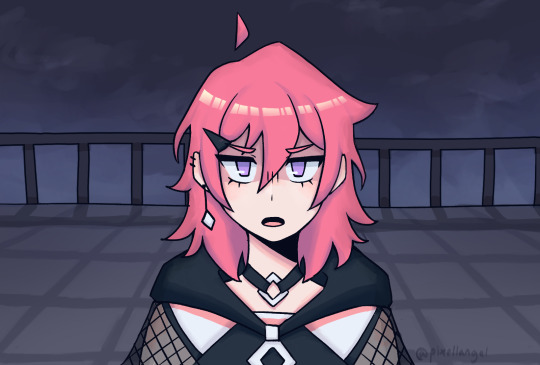
overview - masterpost - taglist
____
Storyteller Synthesis is an indie cyberpunk RPG that I’m currently writing and designing. This is the first scene of the game, where we're introduced to our first party member - a girl named V. Please enjoy!
____
Onyxveil is a troubled city. The streets are covered in litter, the skies are gray with smog, and the only sources of light are flashing neon advertisements on walls. Within this bleak cityscape stands an equally troubled young girl, one with hot pink hair and an unfocused gaze. Just a few years ago, she experienced a horrific eve-
"Can you shut up and give the Player control already? Nobody wants your stupid expository speech."
...Ahem. As I was saying, just a few years ag-
"Why can't you ever listen? The Player isn't interested and neither am I. Get it over with."
Ugh. Fine. I came up with this whole summary, but if you're so ungrateful I GUESS I can throw it in as flavor text somewhere...
"Perfect, I'll make sure not to read it. Now get rid of this black screen so the Player can see."
Excuse me? I know what I'm doing.
"Sure. Just get rid of it."
Ugh. Fine.
[Now, in tile RPG format, we see the aforementioned girl from behind. She's at the edge of a rooftop, looking out into the smog-covered cityscape. The camera shifts downwards to show another person, one with a long, pale blue ponytail. The girl turns around and walks towards them. She keeps her distance, but begins speaking. Her character portrait shows a girl with purple, rectangular irises. Her hair is spiky and she wears some sort of strange cropped techwear hoodie. She looks dissatisfied.]
"So, "Sylvie." Long time no see."
> I could say the same to you.
...
"How long has it been now? Three years? Four?"
> Three.
Not sure.
"And how was your little warrior's expedition? Successful?"
Very.
> You could say that.
Not exactly.
"Good, good. Now, Don't you feel stupid answering these questions when you don't even know who you are?"
Wh- hey! I already told you not to go off script!
> I'm not sure.
Oh. Sorry, you don't need to answer that. Let me just fix this... small bug.
[The Narrator goes silent for a moment and the girl stiffens.]
There! Much better.
[The girl's character portrait is different when she speaks again. Her eyes are wide open with no shine. She has a wide, fake smile. Her hair spikes stand up a little less.]
"So sorry, SYLVIE! I don't know what came over me there. I'm glad your expedition went well! Woul d y ouu be wil lin g to h e-"
[She snaps out of it, shakes her head, and glares up at the sky.]
"UGH!! Stop doing that!!! I would literally NEVER talk like that. You of all people should know. Ughhh... anyway, Player, I'm not gonna keep up the "Sylvie" act. You aren't her and we both know it."
If you go off script again, I'll have to keep acting for you. Get back to the story or else.
"Shush. Player, follow me."
[The Narrator protests as the player follows the her down from the rooftop. The two come to an arcade, which the girl enters without hesitation.]
Ahem. Sylvie. You don't need to go in there. If you would just give me a minute, I can get her to come back out...
Sorry, this is going to take some time. Please be patient.
[The player enters the arcade anyway while the Narrator is distracted.]
"Hey. Glad you could make it."
[The arcade is empty, save for the two of them. Most of the machines look like they're out of order. A few of the arcade cabinets are still working, though.]
"If you're waiting for him to talk, you should know he can't hear us in here."
> "He"?
"The Narrator. He's messing stuff up in Onyxveil, and probably in other cities too. If i had to guess, I'd say his other targets would be The Sunbasked Stratum and Karma Point. They'd be good settings for a story, so..."
> Why can't he hear us in here?
What is he trying to do?
Who are you?
"I dunno. My guess is that he never intended for anything to happen in this arcade, so it's barely more than set dressing. I've never heard him speak a word while I’m in here, though. It’s pretty nice."
Why can't he hear us in here?
> What is he trying to do?
Who are you?
"He's writing some stupid story. I don't know... it's hard to explain, and we probably don't have much time. All you really need to know is that he's meddling with reality for his own selfish reasons and not taking anyone else into account."
[Her face contorts in anger.]
Why can't he hear us in here?
What is he trying to do?
> Who are you?
"My name's V. There's nothing else you need to know about me."
> Who am I?
"You’re the one playing the video game. Obviously."
> That's not what I meant.
"Oh, you must want to know who's body you're in. It's another person from Onyxveil. Their name is Sylvie. They went out on some training journey a few years ago. I... haven't seen them since."
> ...
"It doesn't matter. I need your help, Player. I don't want to be trapped in this stupid reality where I'm a character in a story I never asked to be a part of."
> What do you want me to do about that?
"I want you to help me kill the Narrator."
[V looks determined, but angry. This Narrator person has very clearly wronged her in some way, and based on her face, it looks like it was extremely personal.]
> How are we meant to do that?
"I don't know all the details just yet. However, I think the most effective method would be for us to assemble a party of several people. More people means more firepower, and he already wants us to gather more allies to fight the robots that keep appearing in the city. It'll be easy to fly under the radar as long as we don't discuss it in front of him."
[She speaks quickly and confidently. It seems she's been thinking over her plan for a long time.]
> Do you know who we need?
#pixell.rpg#pixell.art#storyteller synthesis#WHEW this post had a shit ton of work go into it#it was a journey#but AAAAA SCENE 1 FINALLY UPPPP#EXPLODES#uhmm uh.m. i hate to beg but im working really hard on this game and if you reblogged this i would love you forever <3#godddd i would so totally blaze this if i could. but alas#anyway#gamedev#indie gamedev#indie game#writing#original writing#oc#oc art#oc illustration#cyberpunk aesthetic#solo dev#rpg maker#rpg maker game#illustration#art#digital artist#okay thats probably too many tags
31 notes
·
View notes
Text
Introducing Loreteller
Allow me to introduce this project titled "Loreteller".
I have been curating writing tools, nuggets of psychology wisdom, mental models, and story bits for the past decade. I have a background in information systems and creative writing, and have worked in branding and design for a ton of companies.
Corporate marketing psychologist by day, but a creative writer by night: I'm building an expansive world for my novels and curating these tools along the way. In fact, there's a ton of knowledge gatekept by marketers and designers regarding character psychology, compelling writing, and narrative hooks that deserves to be shared.
Loreteller is the synthesis of years of piecing together mental models, plot structures, and narrative systems. Built for brand designers, dungeon masters, marketers, novelists, and storytellers of all kinds - and I'm exciting to share it.
What if you had an encyclopedic list of every aspect of character, plot, personality, and brand?
When I first started my career as a writer, that certainly didn't exist. I hope these tools inspire your own creativity and stories.
Whether you’re a marketer by day, novelist by night, dungeon master by weekend, or all three, these tools are designed to give you the express route to making smart narrative decisions. Or at least, to think outside of the box!
Charactercrafting, storysmithing, themeweaving, worldbuilding, gameforging - there's a ton of info to benefit from, and I'll be sharing bits of it on Tumblr.
See the full list of tools and guides here: https://free.loreteller.com
Let me know if you have any questions!
540 notes
·
View notes
Text
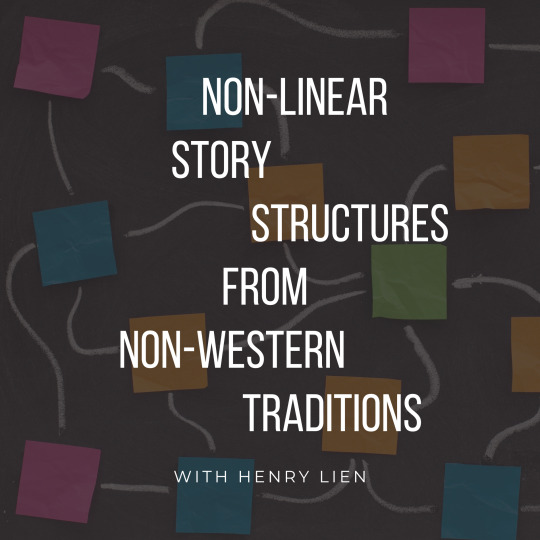
Reg Open: Non-Linear Story Structures from Non-Western Traditions
When: February 25th, 2024 | 10AM – 1PM Pacific Time
Can't make the live webinar? Register to get the recording after
Where: Online — Zoom Classroom
Price: $75 - $100
Scholarships are available - scholarship deadline is February 4th!
“Begin at the beginning,” the King said, very gravely, “and go on till you come to the end: then stop.”
― Lewis Carroll, Alice in Wonderland.
Carroll’s king was clearly not a Chinese king. Western storytelling traditions decree that a linear structure (along with the three act structure, the hero’s journey, and a rising self-esteem arc) are mandatory features of any satisfying story. This is Western-centric silliness. In this webinar, author Henry Lien will explore non-linear structures, specifically cyclic and nested structures, using examples from non-Western stories and films.
Students will come to understand how these non-linear structures allow for thematic stacking, embracing of moral complexity, and a synthesis between form and content to explode the idea that a straight line is the best way to tell every story. The webinar emphasizes practical craft takeaways for storytellers to apply to their own works in progress.
This webinar will run from 10AM to 1PM Pacific Time with short breaks in the middle.
Details and Registration at Writing the Other's website.
29 notes
·
View notes
Text
A long time ago, I had an idea to make a really detailed survey to get a sense of how the average reader consumes stories on simblr, but the project as I imagined it was too ambitious and I lost steam. I decided to revive a version of it using tumblr polls, so I'll be posting a couple questions in the coming weeks/days and then putting together a synthesis post with all the responses.
please reblog so I can get a decent sample size!
91 notes
·
View notes
Text
Storytelling in Our Flag Means Death
I'm just going to make a long post rant about my favorite theme in OFMD and how it shifts over time...I might go episode-by-episode later, if I feel like having an excuse for a close rewatch and a post series if you l like this, keep an eye out because I'm gonna micro-analyze the shit out of storytelling in individual episode groups
We all live by stories. We live stories of our relationships, of our genders, our races, our nations. We live stories that we choose, and stories that were chosen for us. And we each live a story called "I," a synthesis of all these identities and memories. None of the stories are "real," and nothing is as real as the stories. Truths and lies, all in one.
OFMD is full of stories. The characters tell each other stories, they swap stories, they ask for new stories, they reject old stories. They tell their stories, and change through the telling, and figure out what kind of "I" each of them wants to be. What stories they want to tell.
In season 1, the characters go up against the forces of "imperial" stories, stories imposed by the world on individuals to enforce a certain societal structure. Some of those stories are colonial stories about race and class; others are pirate stories about masculinity and what counts as "strength." The characters win some of these battles, and lose others.
In Season 2, the theme of storytelling intertwines with the development of relationships. Storytelling in s2 is, at its worst, an isolating action, distancing the storyteller from the reality and people around them, and even from themselves. But at its best, it's a collaborative act that transforms individuals, relationships, and entire communities.

The original and probably always the most important storyteller in OFMD is Stede. Stede built and crewed this pirate ship because he wanted to tell his own stories, after a lifetime of living under imperial storytelling--meaning the classist, racist, sexist world of his father which imposed certain stories on Stede about what he was and how he was allowed to live in the world.
At the core of Stede's character is the tension of his stories against reality. On the one hand, he wants his own stories to be real, badly. And they're stories that are worth being real: a story where he's able to live the life he chose and made for himself; a story where his crew is safe and comfortable, and able to get in touch with their authentic selves; a story where the past does not define the present. On the other hand, these stories are at odds with the world, and with what Stede secretly believes about himself.
The fun bit is that the imperial stories are actually relatively easy to conquer--out in the world, that is. Reality loses against those stories more often than it wins (because OFMD is that kind of show). All it takes is trust and connection, both of which are grown through the sharing of stories.

Stede tells stories to the crew, and by the end of season 1 they're telling his stories back to him. Izzy tries to tell an imperial story about what a man and a pirate can be when he duels Stede and surrenders them to the English. Stede gets help from Ed and wiggles through the cracks in those stories. Stede's lies become truth, and the truth is more meaningful than anyone thought it could be back when the story began.
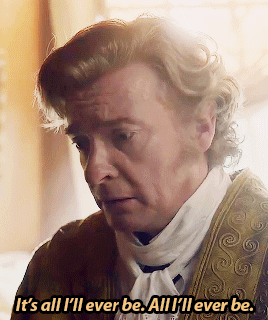
The stories that almost destroy Stede and everything he cares about aren't the ones told by Badminton or Izzy. They're the ones Stede believes. He spends season 1 talking and talking and talking to try to drown out the story that he believes deep down: that he will only ever be a perfect little rich boy, that the only life he should ever have is the one imposed on him by a heteronormative classist society.
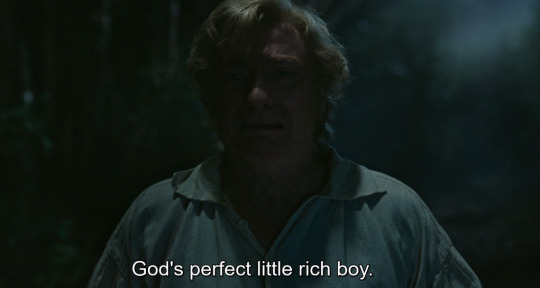

Stories got Stede into this mess. But the thing is, those imperial stories don't reflect reality any more than Stede's pirate stories did back in episode 1. They're just as invented as any other story, as Mary figured out after Stede left ("Being a widow isn't nearly as bad as it's made out to be.")
Good stories have to be told and believed by a receptive audience, as we see when stories fall flat throughout the show (Pete's story of Blackbeard, "a hook for a head," "I don't want your old food.") Stede can tell his stories to his family, but they're not going to become reality. Because he no longer fits in this world. Some of his stories about himself are too far from reality to be true (he'll never win a duel straight up), but others are "truer than true," resonate with a deeper truth in a receptive audience--and then shape reality around him.
Believing stories that weren't true got Stede into his mess at the end of Season 1. But stories also get him out--with help. Because a good fuckery isn't done by one person, it's done by a group.
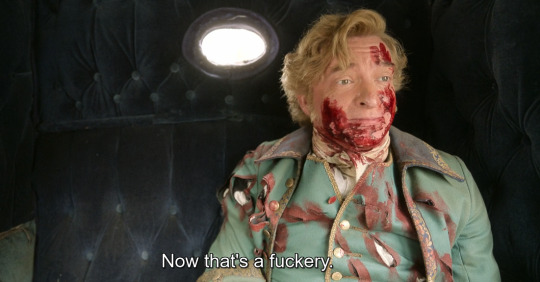
In the first season, Stede learns that imperial stories aren't the only true stories, or the only stories worth living (as Izzy tells Ed when he says Ed would be better off dead than telling a new story). There's no shame in rejecting them when they're inauthentic.
Stede sets out at the end of the season alone, in a small boat, powered by his own body. His pretty clothes are gone and he's got no one to talk to. In episode 9, this sent him into a panicky spiral. In episode 10, he's able to see that freedom for what it is: a chance to write his own rules. To live by his own story.

In season 2, Stede embraces this, embraces the power to tell stories that can reshape reality. Season 2 begins with Stede telling himself a love story. It's a really important story, a story that's going to save both Ed and himself--but it's also a deeply misleading story.
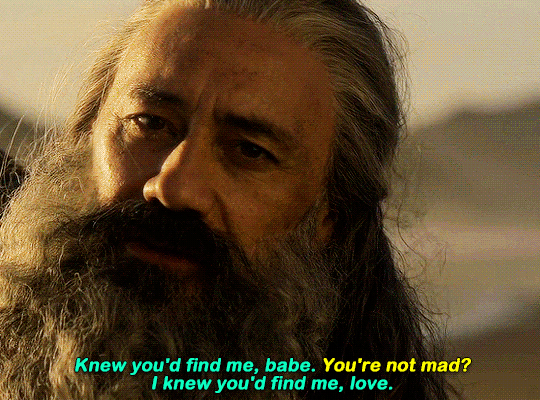
Ed is not the person in that dream, and Stede is avoiding even trying to find Ed because of fears about the weakness of his story. Stede will spend the entire season navigating his way through trying to balance that story with reality, trying to reach Ed where he is.
And Stede will fail, because the trick of the stories in season 2 is that if they're not collaborative, they're doomed. Stede won't reach Ed until Ed's truly ready to risk trusting Stede again, until Ed's ready to tell their love story along with Stede.
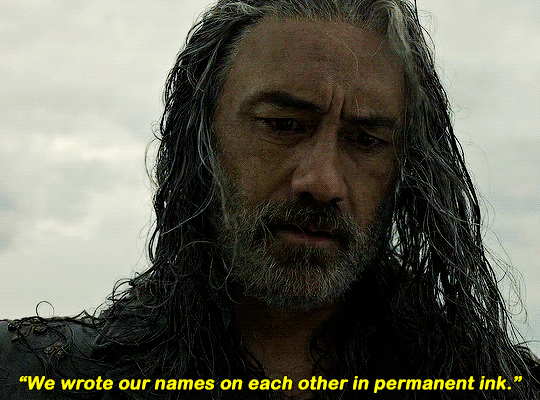
Ed in season 2 is bouncing from story to story, just like in season 1 he experimented (consciously and unconsciously) with one identity after another. Like Stede, he begins by telling a story he doesn't believe, by trying to be someone he isn't. Unlike Stede, that story is limiting rather than liberating. And it very much does not have the support of his crew.
And Ed knows this, knows he can't live by nothing but these pirate codes of toxic masculinity. That he doesn't truly fit them anymore, just like Stede didn't fit when he went home. So Ed starts the season telling a story of the devil, then of an impossible bird, of a treacherous first mate, of a mutinous crew, of a man who wants to die. A cacophony to drown out his pain and fear.
And when Ed does die, he encounters another incarnation of the imperial storytelling of the first season: his own 'ghost,' the internalized incarnation of his white father and abusive class-restricted childhood, of the toxic masculinity Izzy pushed on him. "This is who you should be, this is the only way to live. If you want anything else it means you're weak. If you aren't up for being this person, then you should die. Because you'll never be capable of being anything else. You'll never be worthy of love."

And Ed has internalized and tried to conform to that story, just like Stede tried to conform to the story in season 1. Ed would have died a death worthy of Blackbeard, equal parts madness and violence. A normal death, as he himself knows, as Hornigold points out to him in the gravy basket: "Mutiny, it's always mutiny."
But Ed doesn't die like that. Because just as Ed gave Stede a destination when he left Barbados for the last time, Stede gives Ed a deus ex machina out of the story he's dying in.

And for a shining moment, they're both telling this story. And they will again. They'll run across a beach, each fighting equal battles to get to each other, and they'll know each other more than ever before. For most of the season, Stede is the one holding onto Ed. But by the end of the season, they'll be holding on to each other again.

Ed, like Stede, is going to learn that the stories other people tell about him really aren't as true as the stories he tells himself. Unlike Stede--who mostly just needed to set the toxic stories aside--Ed has to figure out how these stories have shaped him, which are now him, which truly resonate with reality, and which can be laid to rest. Some of Ed's stories are light, some are dark, but all are Ed--and all are loved.
And just as Ed and Stede learn to reach each other in season 2, to communicate and tell a story together, so do the crew. Like Ed, the members of Stede's original crew were changed by their time living Stede's story. Stede created a safe space, where people could tell their own tales and figure out who they wanted to be to themselves and each other. And they begin to pay that forward, even to outgrow Stede.
Jim is the core of this. They use the story of Pinocchio to reach Fang, to make a connection there. To create hope in the face of despair. That connection draws Archie to them. And that power to tell their own story is what lets them defy the rules of the pirate world that Ed is trying to make everyone live by.
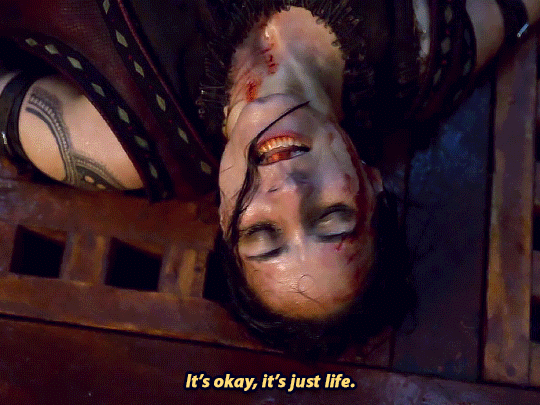

When the crew reunite, they're living fundamentally different stories (just like Stede and Ed have been). Those stories lead to conflict, when the crews first reunite--but then they lead to collaboration. They tell a story of a unicorn, of Calypso's birthday, of a daring escape. And in the end, they lead the crew into the sunset, to write their own stories. Like Stede taught them.


#our flag means death#ofmd#ofmd s2 spoilers#ofmd s2#ofmd spoilers#ed teach#ofmd meta#stede bonnet#blackbonnet#gentlebeard
46 notes
·
View notes
Text
Explorations of Semiotics and Structuralism in 'Take On Me' and 'She Likes a Boy'
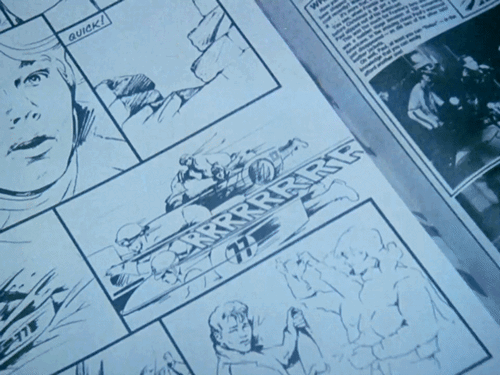
Take On Me
‘Take On Me’ details the epic love story of a man chasing after his dear love, culminating in a moment of passion when the two finally meet, only for the man to leave again. It’s a cute story with tinges of melancholy thanks to the yearning nature and the idea of ‘right person, wrong time.’ Right? Well, that’s what the music video would have you think. Simply looking at the lyrics, which tell of a man consistently pursuing a woman, believing her to be his one true love, trend more towards stalker behavior. It seems this piece of iconic culture is another in a long line of problematic romance that is portrayed as perfectly normal and, in fact, romantic. But why? The answer lies in the signs.
According to Saussure, the sign is made up of a signifier—the sound-image—and a signified—the concept.[1] Here, the signifier is the lyrics that are sung and the signified is ‘love’ or ‘romantic relationships.’ For ‘Take On Me,’ the signified and signifier are unified by the sign that is created during the synthesis of the two: the music video. The concept described in the lyrics is visualized in the music video through a fantastical, reality-breaking story where the narrator of the song pulls the girl he loves into the pages he exists within, then eventually finds her in the real world after she leaves the 2D world. Due to the signifiers utilized in the music video, the audience interprets the entire song and its concept as a positive representation of love rather than the problematic stalker-coded story that is so prevalent in media.
The signifiers in the music video—the sign—point to the mythologization of ‘Take On Me,’ as Barthes describes a myth as a sign becoming a signifier of something else.[2] Barthes also says that mythical signification is “never arbitrary”,[3] so what does that tell us about ‘Take On Me?’ If the reason behind the music video misconstruing the concept and lyrics to create the image of a healthy romantic relationship is motivated by something, what exactly clues us into the motivation?
Metz dictates in “Some Points in the Semiotics of Cinema” that because of cultural or specialized codes that are embedded in our society’s collective understanding, some visuals have implications for the viewer and will be interpreted in a certain way before the cinematic language can tell the viewer what the connotation—and the related denotation—should be.[4] The ‘Take On Me’ music video draws on romance tropes, settings and characters that are extremely prevalent in our cultural understanding of the concept of ‘love’ or ‘romantic relationships’ in a way that evokes a feeling of positive association with the sign. The aesthetic of the diner, a classic date spot, and the plot thread about the straight-laced female love interest being—literally—pulled into the dangerous world of the bad boy are tropes that generate an association with love and romance such that the audience has an idea of what the music video is about before they even watch all of it.

This positive association prevents the audience from interpreting the sign through its signifier, the lyrics. The connotation that the sign evokes through the mythologization the music video participates in is one of a happily ever after romance, but the denotation—the relationship between the concept of love and the lyrics that describe stalker-ish behavior—is one that reveals that the love story between the narrator of the song and the love interest is maybe not so cute.
She Likes a Boy
‘She Likes a Boy’ has a similar concept to ‘Take On Me’ in that they both focus on love and the romantic relationships that ensue from people being in love. But ‘She Likes a Boy’ focuses on the unrequited love, one that is born from a queer person falling for their straight friend—ironically, a trope that has emerged within the canon of queer storytelling. At least, this trope is what the music video posits the song to be about; again, the lyrics and associated concept can be interpreted differently without the music video as a sign to guide the audience towards a particular understanding.
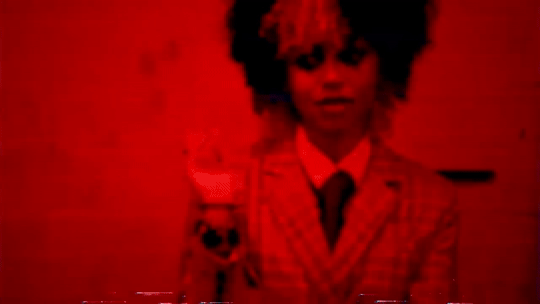
The song was initially released as a single on January 12 in 2024 (though the artist Nxdia released a snippet of the song on TikTok in late 2023), with the music video not arriving until nearly a month later on February 14. This gap gave listeners ample time to interpret the lyrics as they saw fit. Several interpretations match up to the music video’s representation of the signified and signifier as a whole, with lesbians and others that like women lamenting the pain of falling for a straight person, while other videos touch on the insecurity that butch and masc lesbians feel due to presenting more masculine. But due to the “correct” interpretation not being laid out by the music video, other queer people were able to make meaning out of the signifier and signified that completely deviated from the original narrative.
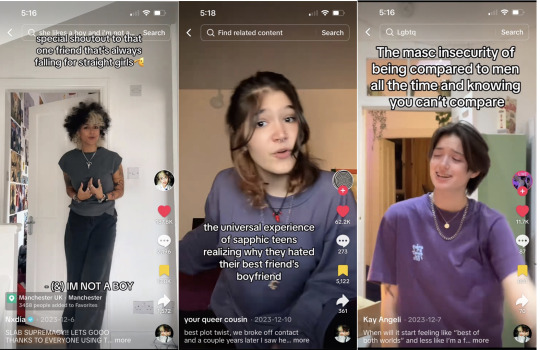
Some transgender men felt they could relate to the song as it described the gender dysphoria they experience on a day to day basis. Hence: how could a girl like me if I’m not a ‘real boy?’ Nonbinary and gender non-conforming folk might interpret the lyrics ‘I’m not a boy’ as ‘I’m not a boy but I’m not a girl either.’ That interpretation encapsulates the experience of people who don’t fall into the categories of the gender binary and as a result don’t know who will love them for themselves. These interpretations were a result of the signifier and signified not being associated with a specific sign due to the music video not guiding viewers and listeners into that line of thinking. Saussure would call this a result of the “arbitrary nature” of the sign, with value and meaning being assigned to signifier/signified relationships nearly at random.[5]
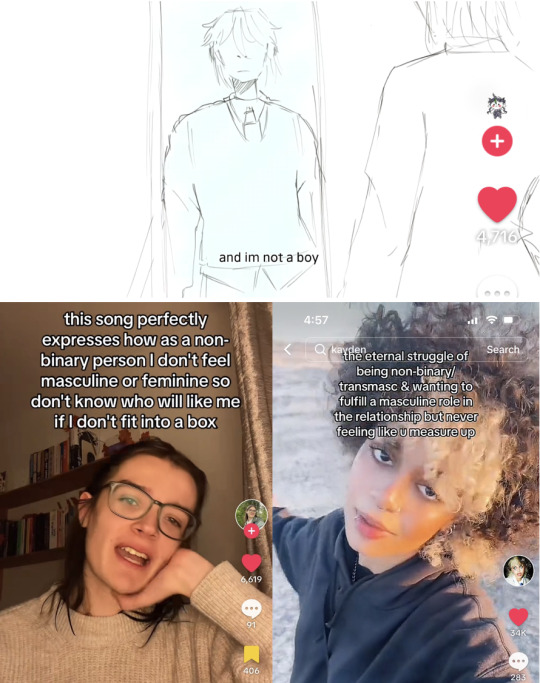
The random nature of the sign’s meaning is at odds with the values assigned to the signified and signifiers within the music video itself. The myth of ‘She Likes a Boy’ is extremely apparent when applying Barthes’ conclusions from “The Great Family of Man.” In that particular essay, Barthes describes how the idealization of our history decreases its value; our past is relegated to something so poetic that it hardly matches up to our current reality.[6] The ‘ideal past’ becomes a signifier for what our life should be, but our actual lives—the signified—isn’t represented by that idealized version.
Something like this happens in ‘She Likes a Boy.’ Nxdia compares themselves to the boy their friend likes, trying to show that there is so little difference between them. The cinematography of the music video also compares the two, with parallel shots used to compare Nxdia and the boy that the girl likes. By highlighting the comparisons, the music video signals to the viewer the idealized reality that Nxdia wants to live in, one where by being comparable to a boy, the girl they like will like them back. But the cinematography also uses lighting in a clever way to distinguish between the idealized reality and the actual life that Nxdia is living. It shows Nxdia playing into the ideal heteronormative romance despite being a queer person, which further complicates the concept of 'love' and 'romantic relationships' in the context of the song.
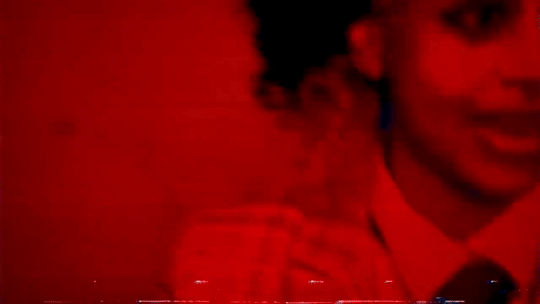
The disparity between signifier and signified is similar to the differing interpretations of the sign by listeners before the music video was released. It seems Saussure’s postulation about the arbitrary nature of the sign was entirely correct; the meaning we assign to the sign is entirely dependent on the associations we have with the sign, its signifier and its signified.[7] From this, we can deduce that there is no correct way to interpret a sign, unless the sign has become a myth in its own right.
Discussion Questions:
How does the presence of two worlds (the world in the drawing and the real world) in 'Take On Me' create layers of myth?
Why might the creators of the 'Take On Me' music video want the love story to be perceived as its connotation (happy and healthy) rather than as its denotation (the stalker behavior lyrics)?
Does the arbitrary nature of the sign add to or subtract from the meaning different listeners assigned to the 'She Likes a Boy' music video?
Is there an inherent 'correctness' to the interpretation of the lyrics to 'She Likes a Boy' based on the fact that the music video outlines one such interpretation?
Works Cited:
Barthes, Roland. “Myth Today” and “The Great Family of Man.” In Mythologies, 100-102 and 106-126. Translated by Annette Lavers. New York: The Noonday Press, 1957.
Metz, Christian. “Some Points in the Semiotics of Cinema.” In Film Theory and Criticism, 65-77. Edited by Leo Braudy and Marshall Cohen. New York/Oxford: Oxford University Press, 2009.
Saussure, Ferdinand de. Course in General Linguistics. Edited by Charles Bally, Albert Sechehaye and Albert Rledlinger. Translated by Wade Baskin. New York/Toronto/London: McGraw-Hill Book Company, 1916.
[1] Saussure
[2] Barthes, Myth Today
[3] Barthes, Myth Today
[4] Metz
[5] Saussure
[6] Barthes, The Great History of Man
[7] Saussure
@theuncannyprofessoro
10 notes
·
View notes
Note
Traditional namers cower before Mooncrafter anon /silly
In all seriousness I like to give even background characters traits and skills, and this affects their warrior names, esp since I use a name dictionary to help decide names.
Gooseberry? Yeah they don’t grow in England but she’s not named after the berry, she’s named after being a medicine cat who also dedicated her life to her clan and medicine, ie a sweetheart
Hailfire? He’s a bold little gray cat encouraged to leave a legacy in the clan and fights well
Cinderdust? A pretty tom with gray fur with silver reminiscent of ashes and plays underhanded tactics to win (ie tossing up dirt and sand and dust)
They’d shiver at Bloomdawn and Briarsong (their mom really likes flowery names since it’s a theme in the family) with Bloomdawn being a beloved cat who’s deputy adjacent and Briarsong being the clan equivalent of a bard and storyteller
All cats should have names that suit them, or something notable about them I feel, but it should also change with the leader- one leader may prefer skill or scar themed names whereas another preferred personality names. :)
Saaaaame you're speaking my language
I always imagine Bramblestar is actually a terrible namer, he tends to not put a lot of thought into the synthesis of the prefix and suffix. Stemleaf, for example,
A "Stem" is the beginning of where any plant connects to the ground or another part of the plant. It's not a "Shaft" or a "Stalk." So by naming him "Stemleaf," Bramblestar invoked the image of... a leaf growing out of the ground.
Twigbranch, too, implies a tiny little twig sticking off a tree.
Thriftear implies she is trying to listen to thrift plants, or hiding in a sparse patch of tiny seaside flowers, very unimpressive.
While the suffixes fit each warrior, they're actually considered pretty terrible because they don't vibe with the prefix. I like to think it's one of the reasons everyone is annoyed Nightheart got to just REJECT his name like, "I thought we all had to just live with our awful Brambletitles!!"
33 notes
·
View notes
Text
I just finished the last episode of Star Wars: Visions II and I gotta say, there wasn’t a single episode that didn’t amaze me in its own way. Inviting studios from around the world to tell their own independent stories breathes an incredible originality and authenticity into the universe. That different peoples can take the stories and world of Star Wars, find their own meaning through synthesis with their own lived experiences, then harness that emergent creativity to put work back into the universe exemplifies what I see as the true strength of fictional universes as shared narratives: its capacity as kind of modern mythology, a wellspring of themes, ideas, and relationships that people can find themselves in and use as a framework to tell their own stories. Visions is a testament to that inherent potential. The resultant diversity of stunning animation and powerful storytelling just fills my heart with joy and hope.
Star Wars belongs to everyone. At its core, it has always been about solidarity, connection, and hope persevering in the face of overwhelming darkness, and how positive change is contingent on their presence. I am grateful this show grants me the opportunity to experience what that looks like through other people's eyes, sharing their own sociocultural perspective and weaving it into a unique vision of what Star Wars is.
23 notes
·
View notes
Text
Mass Effect Trilogy Tag
Was tagged by @illusivesoul
Thank you! 😊
Tagging (if you feel like it, of course): @mxanigel, @lady-carys, @wolfmilk-and-polenta
Answers under the cut! (Quite a bit of rambling there, I'm afraid...)
I have been a fan since:
Favourite game of the series?:
MShep or FShep?:
Earthborn, Colonist or Spacer?:
Biotics or Tech:
Paragon or Renegade:
Favourite Class:
Favourite Companion:
Least favourite Companion:
My squad selection:
Favourite In-game romance:
Other pairings I like:
Favourite NPC:
Favourite Antagonist:
Favourite Mission:
Favourite Loyalty Mission:
Favourite DLC:
Control, Synthesis or Destroy:
Favourite Weapon:
Favourite Place:
A quote I like:
I have been a fan since: 2021. I had been meaning to try the first game since 2017. I played for one evening, then life happened and I forgot about it. Fast forward to the 2021, when having less work and no longer having a commute made me go 'well, why not use this time to mitigate my existential dread and deaden my emotions with... oh. Okay. Nevermind that'. And then I sank... I don't know, a little under 200 hours into it? Yeah.
Favourite game of the series?: ME2. I think I like the stakes and storytelling of ME3 better (also, I think it was the first game to ever make me cry? Several times?), but ME2 is very character-focused and I just live for that.
MShep or FShep?: Well, I usually play as female characters (the one recent exception I can think of being a M!Cousland because that was the only way marry Anora. I have no regrets.) so I'm not really in a position to compare.
Earthborn, Colonist or Spacer?: Earthborn on my Paragon playthrough, colonist on the Renegon one. (I also started a spacer one but did not finish it).
Biotics or Tech: Both, but for different reasons. I like the visuals of biotics (yes, I really am that shallow), and having an enemy NPC floating helplessly in the air while you take aim is really, really convenient. That said, the 'overload' ability is extremely helpful, and I really like Tali's little drone, so tech is pretty cool too. I just usually make sure I have both in the squad (except for specific missions like the moon base in ME1).
Paragon or Renegade: Hmm, so... I'm going to say Renegon, because Renegade is very entertaining at times, and absolutely awful at other times (particularly in ME3). But my first Shepard was a bleeding heart Paragon. She was just so nice.
Favourite Class: Anything that lets me experience the story without dying too many times (and I play on casual so that's really all of them). That said, I find myself rather partial to the Vanguard's charge ability. It's not necessarily the *most* useful, but it's just too satisfying not to use.
Favourite Companion: Hmm. Well, I love EDI's dry humour and the fact that she becomes more human over time, so I'll just go with EDI...But honestly, it is a tough choice, especially when old grump Javik is right there, and Tali melts my heart, and Liara's arc is so good, and Wrex is too funny but also pretty tragic, and... see what I mean?
Least favourite Companion: Jacob. The thing with Jacob is, I don't even dislike him, I just think his writing is... how do I put it? Not bad, per se, but it doesn't quite pull me me in. He's pretty much the only companion who remained 'a coworker' on all my playthroughs. Other were either 'best pals' (Tali, Garrus, Wrex), great romances (Liara, Garrus, Thane), or downright antagonistic at times but in a way that felt natural and brought something to the story (Miranda and Jack come to mind).
My squad selection: I don't have a fixed one.
Favourite In-game romance: Garrus
Other pairings I like: Miranda/Jack, Javik/Liara, Tali/Garrus, Nyreen/Aria
Favourite NPC: Matriarch Aethyta
Favourite Antagonist: Saren
Favourite Mission: Virmire
Favourite Loyalty Mission: Tali/'Treason'
Favourite DLC: I haven't played them all (I haven't bought the Legendary Edition so they were separate purchases. This means I have never recruited Kasumi or played Lair of the Shadow Broker, any knowledge I have of them comes from the fandom + a couple of videos), but I really enjoyed the Omega DLC.
Control, Synthesis or Destroy: Oh man... I mean... I feel like Control comes with fewer moral downsides in the short term? Organics remain organics, so no consent issues there, and the Geth and EDI get to survive... the only real downside is that Shepard is gone. But in the long term? Who's to say they're not the new big bad? It's the one I went with on my 'Renegade' playthrough and her monologue was pretty chilling. Also, there's a degree of sadness in her being 'still there but gone'. What does the grieving process look like for Liara (or whoever else was romanced)? For Shepard themself? Isn't it lonely up there? I don't know, there are just so many questions. That said I went with 'Destroy' (and high EMS) on my first run because I looked up a wiki as I played and I wanted Shepard to survive. Let her and Garrus adopt baby Krogans.
Favourite Weapon: Ermm. I'm not good with names (or details in general for that matter 😂) but that big Prothean rifle you find in ME2? Yeah. That one.
Favourite Place: Ilium. Again, I am shallow. Though I initially mistyped that as Ilos (again, I am bad with names) and you know what? I love Ilos too, but more for the feels than its aesthetic. Also Liara's reactions. And the music when you get to Vigil.
A quote I like: "You did good, child. You did good. I'm proud of you." Man, the delivery got me right in the feels.
4 notes
·
View notes
Note
What is Gintama about? The only thing i know about it is a clip of a Character explaining how filler in anime works.
I mean, the easier question to ask here is "What is Gintama not about?" But okay, lemme see if I can answer efficiently.
On a base level, Gintama's premise is "Hey, remember that time in the 19th century where Western powers forced Japan to open its borders and started colonizing it with foreign influence? What if that, but instead of America and Britain it was aliens?" So it takes place in a 19th century Japan that's been colonized by super-advanced alien races, meaning you've got traditional, pre-industrialization Japanese buildings and infrastructure side by side with futuristic skyscrapers and UFOs. The protagonists are a trio of down-on-their-luck bums who run an odd jobs service and get involved with all sorts of wacky and unusual goings-on around Edo.
So essentially Gintama starts out as: Deadpool: Sci-Fi Alternate History Sitcom Edition. Its humor is irreverent, ridiculous, self-referential, often dirty, often fourth-wall-breaking, and almost always hilarious (I cannot stress enough, this is the good version of Deadpool humor I'm talking about). And at first, it seems content to mostly just be an episodic comedy with an interesting setting. But then...
Well, perhaps this paragraph from my review of the first 200 episodes best sums it up.
"Swiftly and surely, moment after dazzling moment, this show proved itself to be a show with no limits. Every time I thought it had exhausted its capacity to surprise me, it reached into its bag of holding and pulled out such an unexpected new flavor of story that I was forced to completely re-evaluate what I knew it to be capable of. From goofy, irreverent comedy, it proved itself capable of meaningful thematic explorations. From meaningful thematic explorations, it proved itself capable of a sincerely touching humanity. From a sincerely touching humanity, it proved itself capable of a mastery of the meta of its own place in popular culture that exceeds any other story I’ve seen. From a mastery of its own meta, it proved itself capable of awe-inspiring spectacle that left me cackling in shock. From awe-inspiring spectacle, it proved itself capable of wrenching character drama that left me sobbing in my seat time and time again. From wrenching character drama, it proved itself capable of bringing all those elements together into a synthesis of storytelling prowess, juggling so many disparate tones and styles and making them all feel part of the same massive, sprawling universe. And from there, it proved it could just as easily just do goofy, irreverent comedy again and still have it carry all the weight of its established internal mythology."
The bottom line is, what starts as seemingly just a really funny sitcom grows and evolves until it's capable of anything and everything you could ever want from a story, all at the same time. It's one of the funniest comedies I've ever laughed at, one of the most affecting dramas I've ever cried to, one of the most pulse-pounding action thrill rides in shonen history, and the undisputed title holder of the single best cast of characters I've ever seen. Even those seemingly simple meta jokes eventually grow to become a full-blown commentary on the art of storytelling itself, as Gintama uses them to bludgeon tired, problematic tropes into the dirt in order to replace them with better, more progressive alternatives. Not to mention how that alt-history setting is mined for genuine political philosophy. And it accomplishes all that while still primarily being a really funny sitcom... except it's also building up its own epic narrative in the background of that sitcom, piece by piece, until it finally knocks over the longest chain of narrative dominoes ever constructed for a final act that, frankly, blows the entirety of One Piece out of the water all on its own.
That is Gintama. That is the greatest work of fiction I've ever had the pleasure to experience. If any of that sounds interesting to you, give it a shot. I know the length is intimidating, but trust me: it's the most rewarding marathon you'll ever run.
103 notes
·
View notes
Text

the official (for now) weapon designs for my cyberpunk rpg, storyteller synthesis!! people have been asking for them and i am here to serve my lovely fans <3
i also included the characters' signatures next to each of their weapons! initially they were just space filler but they actually ended up being really fun and im very glad i added them :D
masterpost link (all the other info on ss is here if you'd like to check it out!)
#pixell.rpg#storyteller synthesis#gamedev#indie gamedev#indie game#game design#rpg#rpg maker#game development#weapon design#cyberpunk aesthetic#also!! the little charms on sylvie's katana are friendship charms from when they were friends with v as a kid :3#v has a matching set
20 notes
·
View notes
Text
I also of course love in stories when you are presented with only two competing options, and neither are attractive solutions, and/or the conflict is in a stalemate because of it, but then the relief is that a third option is possible. The 'knot' is unravelled. Even better when the third option is a synthesis of those two ideas, which kind of retroactively transforms them too.
I also think this is a good way of looking at the mechanics of storytelling in general (e.g. with competing character motives, or things required to get you to the endgame). But I am always a fan of it because I love characters in impossible situations with solutions nobody could see yet, especially in fandom at a speculative level.
In the example of Adam and Eva, paradoxically what they were both doing was necessary, and it's only through both preservation and total annihilation that one nanosecond of transformation bleeds open.
More specifically, I was crying when Jonas had that one moment of hope. It was all that was needed.
#I'm toying with how much I want to write about Dark#I think you should watch Dark if you haven't yet#it's on Netflix#be warned it's very graphic and unapologetic but it doesn't feel voyeuristic#I also think they do very specific things with the material they choose to portray#e.g. the sex scenes between certain characters vs. Jonas/Martha where one is antiseptic and theirs is warm golden and intimate#and secretive
2 notes
·
View notes
Text
Solo + LLM, some ideas
Throwing together some thoughts on playing solo TTRPGs with help from LLMs (Large Language Models, "AI", GPT, etc.). I'll throw up a cut so people who hate the idea can click and move on. Mostly I've been using LLMs as a way to expand or contextualize oracles, tables of words or phrases that are used to inspire what comes next.
Lesson 0: If the Answer is Obvious, Don't Use an Oracle (or Mechanic)
I'm sure many people have done this at least once, tried something impossible in a game hoping for an "automatic success" (natural 20 in D&D terms). At the other end of the spectrum, there are playstyles where you roll (or ask to roll) for trivial tasks and observations.
Oracles are useful for those moments when you don't know what happens next. Your characters (and you) are bored with travel scenes, so you need something to spice things up. But your brain is just churning on a lot of nothing.
Lesson 1: The LLM is a Bad GM
LLMs (at least as of 2024) are bad at synthesis, facts, math, and long-form storytelling. They are ok at making surface-level connections, suggestions, and "what happens next" (within the limits of what something trained on wikipedia, twitter, and reddit can do.)
Lesson 2: Provide Context
GPT is a "conversational" LLM. It can (within limits) remember earlier parts of the conversation. Give it one paragraph of the story so far. Describe genre and setting.
Lesson 3: Brainstorm
"Give me five ideas for..." Asking for one answer will likely get you something that doesn't quite work. Instead, ask for five suggestions and pick the one you like best.
Lesson 4: Critique, Argue, Rewrite
IMNSHO the real challenge of writing or GMing isn't ideas it's development. Treat LLM suggestions as thumbnail sketches or scribbling on a whiteboard. Take the most interesting idea, and argue with it. Keep what works, critique or rewrite what doesn't. Arguing with a bad idea helps clarify what you want from the scene.
Unleash your internal editor on those ideas.
Lesson 5: If it's not Fun, Do Something Else
I enjoy bouncing ideas off of a group or LLM. Other people use notebooks or rubber ducks. If it's not fun, and not moving your game forward, try something else.
2 notes
·
View notes
Text
How to Turn an Idea into a Story
Once you’ve generated an awesome story idea to pursue, the next thing to do is to flesh it out, so that you can actually write the story. If you’re like me, and you need to have a little bit of structure in place before you draft, then I have an idea I want to present to you. The foundation of this idea is the MICE Quotient, a storytelling framework with rules that help you tell cohesive narratives. By combining that with the idea of Elemental Genres (which was imparted to me by the amazing Writing Excuses Podcast), you get a framework that incorporates more story elements, specific to the genre(s) you’re using.
Steps
The general steps to use this framework are:
Create your story prompt using divergent and convergent thinking (I made a post about a potential process for this)
Think about the Elemental Genres of the story
Think about the MICE elements of the story (I made a post about a potential process for this)
Think about the elemental subgenres
Bring it all together
Step One: Getting the story prompt
Using the methods of idea generation and idea synthesis, figure out a basic idea of what your story is going to be. By the end, you end up with something resembling a logline or short paragraph synopsis (or something in between). For inspiration, you can look at stories in the public domain, the news, your own life, and other art, the options are endless.
Step Two: Choosing Elemental Genres
Elemental genres aren’t what we traditionally consider story genres. When I hear the word genre, I think of things like Science Fiction, Drama, Buddy Cop, etc. There’s some overlap name-wise between elemental genres and the traditional idea of genre, but they represent different things. Genres as we think of them usually are meant more to classify for the sake of the audience…it’s more of a categorization tool. Elemental genres are meant to bundle certain emotional responses to that story. A particular elemental genre is decided by the ideas that the story presents AND the emotions that stories in that elemental genre try to illicit. Also, note that elemental genres are used to tell stories in traditional genres. As an example, Science Fiction stories prescribe more to the themes, settings, and characters than an elemental genre would. A SF story could have any of the elemental genres, and any of the elemental genres can be used in the SF context.
The elemental genres are wonder, idea, adventure, horror, mystery, thriller, humor, relationship, drama, issue, and ensemble. You can probably come up with more using story analysis, but that’ll do for now.
Choosing your story’s foundational elemental genre requires you to look at your idea and think about what overall emotions you’re trying to get from the audience. If it’s a sense of awe, then your story’s main elemental genre is a wonder. If your story is about the limits of human physical ability, then it’s an adventure story. Each elemental genre elicits its own emotions.
To make sure that this is clear, I’ll use the example of elemental horror versus traditional horror. If you were to ask the point of a horror movie, it would be to cause fear. You might say that for one that has elemental horror, or is just broadly in the horror genre. The power of elemental horror allows you to understand what makes a horror movie tick, and apply that in new, other contexts. Horror in the traditional genre sense will usually fall into the monster, slasher, or psychological camps, and while there can be unique takes on these, they are all working from more surface levels of inspiration. Elemental horror can be a completely different kind of experience. An elemental horror story can be one where the protagonist(s) have to generally deal with horrible things, and we see their reaction to it and hope for the best while the story doesn’t really give us strong signals that things will end up okay. In this context, seemingly silly things can become horrifying given the right character context and reactions.
For more detail on specific genres, I have a document that I’ll link here with the elemental genres and describe how to use them.
Step Three: MICE Elements
Now, we start to get into actual story events. I have a longer explanation of the MICE quotient here, but the basic idea is that the MICE quotient is relating to four different elements of the story. M is for Milieu, which is the location where story events happen. I is for Inquiry, which is a driving question for the story that a character has. C is for Character and relates to some character flaw a character has and their journey to overcome it. E is for event and relates to something that happens in the world of the story that disrupts the status quo, and the character(s) journey to restore that status quo.
Think of mice elements like nesting dolls, holding your story in the middle. If you start the story with a MICE element, you have to end it with that same element. The second element gets resolved second to last. And it just continues, for as many of the elements as you decide to use.

In my post about the MICE Quotient, I go into more specifics on how to use it.
Step Four: Elemental Subgenres
Elemental subgenres are incorporating the parts or aspects of one elemental genre in the story that is primarily of another elemental genre. If our story is primarily an elemental adventure story, which is focused on the physical challenges driving the narrative, a subgenre implementation could be an elemental issue, where the adventure has a subplot of a greater political conflict that underscores the physical challenges. Subgenres can vary in amount and importance; they can be as short as a moment or span most of the story. Subgenres are used to enhance the narrative and build off of the themes and ideas of the MICE elements and primary elemental genres.
My Example
I’m going to bring all of these steps together by using this process for a story idea I have. The initial idea is: A god/deity falls in love with a human, and this union creates an equalization; the god loses some godliness, which is gained by the human. They both become equivalent in power to demigods.
Step One: Story Prompt
Through my story idea development process (explained in detail here), I came up with this story prompt: The worlds of gods and humans are ruled by centralized, hierarchical power structures that provide unsustainable decadence for the oligarchs at the expense of everyone else. One god and one human see each other as a haven to experience freedom from their current realities. The solidification of their relationship leads to them both becoming demigods, disrupting the status quo. To preserve themselves and their relationship, they have to contend against both worlds. Part of this involves sneaking into a council between the gods and humans and using the neutrality of the meeting to plead their cause.
Step Two: Primary Elemental Genre
Based on this description, I want the elemental genre to be drama. Drama is focused on the growth of the characters, and how that impacts the world. I pick this one because while the prompt lends itself well to the elemental romance genre, I want the story to be focused less on the trials and tribulations that the couple has with each other, and more on how their union causes hardship for them as partners, in opposition to the status quo.
Step Three: MICE
Now, with the idea and main elemental genre in tow, I can input the MICE elements to create the skeleton of my story.
<Xₓ> is opening/introducing an element
</Xₓ> is closing/resolving an element
<C₁> The god and the human protagonists long to be together corporally. The god can astral project to the human, but can’t easily come to our world. They want this because the closest thing they know to true happiness is each other.
<E₁> The two are able to meet in person due to a transgressive plan they craft together. This sets off a chain of events, transforming them both into demigods.
<I₁> The couple has to figure out how to survive and find a new life against both angry gods and jealous humans
</I₁> The couple meets a pocket of little-known dissenters to the hierarchical nature of the worlds they come from. Gods and humans from all backgrounds living in harmony show them that there is a possibility for a future centered around equality and solidarity.
</E₁> The couple are able to carve out a stable peace in the world, separate from the fighting both sides had to do in order to be together.
</C₁> The two finally achieve that real happiness they were looking for, not only from their love which has been forged in fire but the community that they’ve built along the way for this journey.
Notice how the elements are set up like nesting dolls; they have their own order that has to be followed.
Step Four: Subgenres
The secondary genre of the story that I want to explore is issue. Issue is all about a topic being discussed through the story. An issue element that will enhance the primary elemental genre is the exploration of the influence of hierarchy and power consolidation on the protagonists. We’ll see different points of view on the topic, and different philosophies will clash to challenge our protags and make them think critically about their worldview and the motivations behind it. Relationship, Humor, and Thriller would also be big subgenres.
All together:
<Drama>
<Issue>
<C₁> The god and the human protagonists long to be together corporally, as the god can astral project to the man, but can’t easily come to our world. They want this because the closest thing they know to true happiness is each other.
<E₁> The two are able to meet in person due to a transgressive plan they craft together. This sets off a chain of events, transforming them both after they hook up into demigods.
<Thriller>
<I₁> The couple has to figure out how to survive and find a new life against both angry gods and jealous humans
</I₁> The couple meets a pocket of little-known dissenters to the hierarchical nature of the worlds they come from. Gods and humans from all backgrounds living in harmony show them that there is a possibility for a future centered around equality.
<Humor>
<Humor>
</E₁> The couple is able to carve out a stable peace in the world, separate from the fighting both sides had to do in order to be together.
</Thriller>
</C₁> The two finally achieve that real happiness they were looking for, not only from their love which has been forged in fire but the community that they’ve built along the way for this journey.
</Issue>
</Drama>
One thing that I want to note is that while the MICE elements have to nest in a particular way, the same isn’t true for elemental subgenres. Elemental subgenres can show up as flashes in the story, appearing and disappearing within a single scene. They also don't necessarily have to close in a specific order like MICE elements
Conclusion
From here, I usually flesh out different characters, then I write a scene-by-scene outline. If you tend to explore more through drafting, you can start writing here, or plan out scenes in more detail—whatever works best for your process!
If you want more information on each elemental genre, I can’t recommend season 11 of Writing Excuses enough. This is one of the best things I’ve found in my creative writing journey. My own notes for the season are here. Anyway, I enjoyed coming up with this story idea. Now it’s time to get back to writing my current story!
#writerblr#writing#creative writing#writers of tumblr#writers of color#writerscommunity#writers and poets#writers#writing adventures#writblr#writeblr#writing community#writers on tumblr#writer problems#writing ideas#writing techniques#writing advice#storytelling#how to wr#fiction writing#how to write fiction#story ideas#short fiction#short stories#how to write
12 notes
·
View notes
Text
A long time ago, I had an idea to make a really detailed survey to get a sense of how the average reader consumes stories on simblr, but the project as I imagined it was too ambitious and I lost steam. I decided to revive a version of it using tumblr polls, so I'll be posting a couple questions in the coming weeks/days and then putting together a synthesis post with all the responses.
please reblog so I can get a decent sample size!
52 notes
·
View notes
Text
A Note on the Collaborative Nature of the Realms
The Realms are a living entity, feeding on the creative energies of all its contributors, writers, artists, and map-makers.
-Jeff Grubb, May 1990
Since the days of old, when Ed Greenwood himself began to play with and construct the Forgotten Realms as we know them, the Realms have been a creation of many. In the introduction to the 1990 Forgotten Realms Atlas, both Greenwood and Grubb write their introductions in praise of the work that has been accomplished by each and every contributor, most of all Karen Wynn Fonstad, the artist behind this book.
Part of the allure of the Realms for myself is that collaboration. For 35 years, people around tables, among friends or in writing alone, have all added their own pieces to this world, this section of the multiverse. For years before anything involving the Realms was ever published, Ed Greenwood and his friends constructed the bones, they filled the seas.
Whether it be the dozens of novelists who have woven together the setting, or the players that have inhabited it, everyone who have set foot in the Realms has, in some way, shaped it.
In that same vein, not all minds think alike. For these decades, each artist has just a slightly different view of the worlds of Abeir-Toril. That is the nature of art, no two people’s interpretations are going to be the same. In many ways, those interpretations are encouraged in a collaborative storytelling medium such as Dungeons and Dragons. However, after so many years, pieces of what is canon can become... muddled. They sometimes contradict each other, or misplace items on timelines.
But, isn’t that how history works? We must study it, to pick apart what remains and decide what we know, what we speculate, and what we may never fully comprehend.
That is to say, that going forward with this project, I will focus on research and I will site my sources. However, I will also be adding in my own interpretations of these people and places. The synthesis of the things I have learned will no doubt be missing something, or change something. I guess that means that it is “my” version of the Realms. But it isn’t, is it? Because no matter what, these are our Forgotten Realms. Each of us are just cartographers, mapping what we see as most important as we travel across these lands.
“...for the Realms belongs now to all of us. Elminster showed it to me for the first time over twenty years ago, and I’ve since shown it to you. I wish you the same fun exploring its life, mysteries, splendors, and odd corners that I’ve had, thus far.
- Ed Greenwood, January 1990 (Forgotten Realms Adventures, TSR)
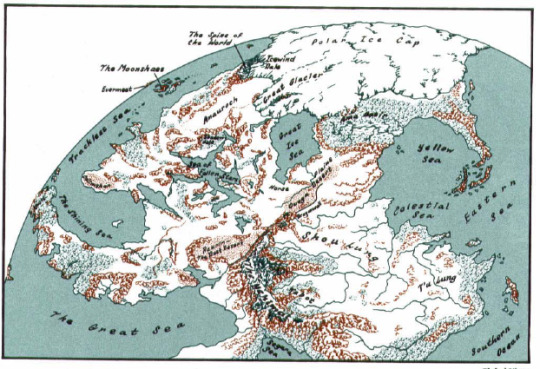
And, as a treat for reading to the end, take a look at this beauty! I will try to get a clearer scan, but I have never see a map of Toril from this angle, and Karen Wynn Fonstad really knocked it out of the park on this one.
#meta analysis#forgotten realms#collaborative storytelling#dungeons and dragons#faerun#ed greenwood#mapmaking#forgotten realms atlas#D&D#dnd
10 notes
·
View notes